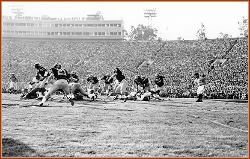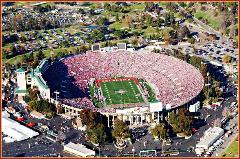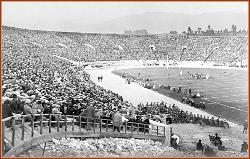



Now in its 79th season, anyone who has played in McArthur Court will testify it's a special place. Picture a four story, classically architectured
pavilion. From the outside, you can hear the roar of the crowd.
Inside, it's packed to the roof with the deafening cheers of nearly 10,000 boisterous fans. Overhead, three balconies vibrate to the sound of
Oregon's pep band and rally squad and the scoreboard suspended over midcourt appears to quiver. The atmosphere is electric.
That's what it's like in McArthur Court, which is better known by players and visitors alike as "The Pit." It's the consummate place to stage a
game. Opponents cringe at the thought of playing in Mac Court. Fans speak of it with unmatched reverence.
Named after Clifton N. (Pat) McArthur, a student-athlete and the university's first student body president, Mac Court is one of the primary
attributes of Oregon's athletic program. Visitors liken the fabled west coast facility to the Boston Garden in the east.
According to a recent poll, McArthur Court was deemed as a Pac-10 visiting team's least favorite place to play. In 2001, The Sporting News
named it the "best gym in America," and in 1995 Sports Illustrated listed it as one of the 12 toughest places in the country to play at the collegiate
level. Students sit at courtside and the atmosphere just before the start of a game is tingling.
Oregon's fans are an integral part of the ambience. The Ducks have ranked annually near the top of attendance figures in the conference and
the setting is the favorite of the many television producers and announcers who cover games at Mac Court. The flavor is easy to capture for their
audiences.
McArthur Court was built in 1926, with the first game staged January 14, 1927, when the Oregon men's basketball team beat Willamette 38-10,
and has since undergone numerous modifications and upgrades.
The Associated Students of the University of Oregon decided to "tax ourselves to build what we want" and their desires included an indoor arena.
McArthur Court was thus paid for out of a $15 fee imposed by the ASUO. During 1932, one of the worst depression years, the mortgage was
burned in a public ceremony after the Court had been completely paid for.
Even with its tradition, McArthur Court is a modern facility. The building has undergone more than $5 million in renovations over the last decade.
The maple floor, used for the 1990 Goodwill games in Seattle, has drawn raves for both its durability and its "give," making it easy on players'
legs.
In 1992, new locker rooms, a team room and coaches offices were added for the men's basketball team, and in 1993, volleyball, women's
basketball and softball received significant upgrades to their locker rooms. In 1996, a $400,000 renovation of the outer concourse on the street
level was completed and the department of Academic Services for student-athletes was completely updated and redesigned.
The venerable facility also received a new roof in the summer of 1996 to the tune of $1.7 million and new court-level seating was completed in
the fall of 1997, making it a viable venue for numerous events well into the 21st century.
During the summers of 2000 and 2001, the outside facade of Mac Court received a face lift with the installation of new windows, the removal of
dead ivy and a compressed air pressure cleaning. Inside, the basement received new carpeting and a fresh coat of paint. The capacity was
raised from its original 6,000 seats to 7,600 with a series of additions between 1934-1953 and another expansion in 1955 upped the capacity to
9,100.
Further renovations allowed for as many as 10,063 fans when the upper two balconies were expanded to encircle the arena, but recent
alterations to the floor-level seating have dropped the capacity to its current total of 9,087.






